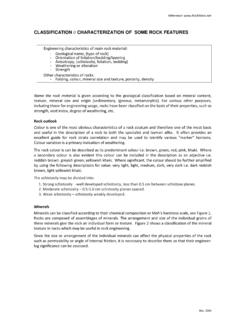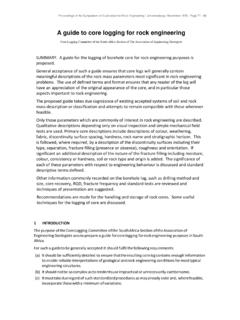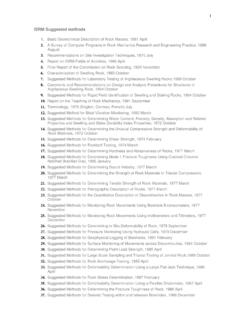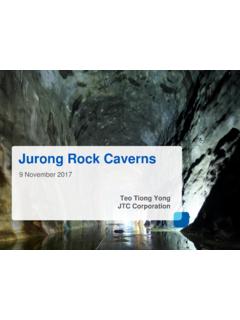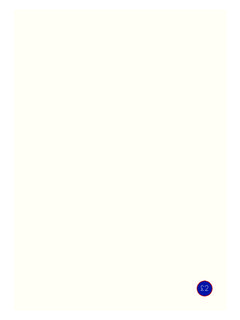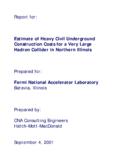Transcription of Short on the Q-system - RockMass
1 Short on the Q-system The Q-system for rock mass classification, developed at the Norwegian Geotechnical Institute (NGI) in 1974, originally included a little more than 200 tunnel case histories, mainly from Scandinavia (Barton et al., 1974). In 1993 the system was updated to include more than 1000 cases (Grimstad and Barton, 1993). It is a quantitative classification system for estimates of tunnel support, based on a numerical assessment of the rock mass quality using the following six parameters: Rock quality designation (RQD). Number of joint sets (Jn). Roughness of the most unfavourable joint or discontinuity (Jr). Degree of alteration or filling along the weakest joint (Ja). Water inflow (Jw). Stress condition given as the stress reduction factor (SRF); composed of Loosening load in the case of shear zones and clay bearing rock, Rock stress in competent rock, and Squeezing and swelling loads in plastic, incompetent rock.
2 The above six parameters are grouped into three quotients to give the overall rock mass quality: SRFJJJJRQDQ warn = The first two parameters represent the overall structure of the rock mass, and their quotient is a relative measure of the block size. The second quotient is described as an indicator of the inter-block shear strength. The third quotient is described as the active stresses . The ratings of the various input parameters to the Q-value are given in Table 1. The Q-value is related to tunnel support requirement by defining the equivalent dimensions of the underground opening. This equivalent dimension, which is a function of the size and type of the excavation, is obtained by dividing the span, diameter or wall height of the excavation (Dt) by a quantity called the excavation support ratio (ESR), given as: ESRDtDe= Ratings of ESR are shown in Table 2 The Q-value in Figure 1 is related to the total amount of support (temporary and permanent) in the roof.
3 The diagram is based on numerous tunnel support cases. Wall support can also be found using the same figure by applying the wall height and the following adjustments to Q: For Q > 10 use Qwall = 5Q For < Q < 10 use Qwall = For Q < use Qwall = Q Table 1. Description and ratings for the input parameters of the Q-system (simplified from Grimstad and Barton, 1993). RQD = 0 - 25%Jn = - 125 - 50250 - 75375 - 90490 - 1006 Notes:9121520Jr = filling (< 5 mm)Thick fillingJw = - - = / s1s / scSRF> 200< - - - - - 25 - - - 503 - - 150 - 200< 2> 1200 - 400s / scSRF1 - 55 - 10> 510 - 205 - 1010 - 15 RQD (Rock Quality Designation)Jn (joint set number)SRF (Stress Reduction Factor) i) Add if the mean spacing of the relevant joint set is greater than 3 m ii) Jr = can be used for planar, slickensided joints having lineations,Notes: provided the lineations are oriented for minimum strength are sufficiently accurate Crushed rock, earthlikeNotes: (i) For tunnel intersections, use ( x Jn).
4 (ii) For portals, use ( x Jn) Very poor Poor Fair Good Excellent(i) Where RQD is reported or measured as < 10 (including 0), a nominal value of 10 is used to evaluate Q (ii) RQD intervals of 5, 100, 95, 90, etc. Two joint sets plus random joints Three joint sets Three joint sets plus random joints Four or more joint sets, heavily jointed, "sugar-cube", etc. Massive, no or few joints One joint set One joint set plus random joints Two joint setsModerate slabbing after > 1 hour in massive rockSlabbing and rock burst after a few minutes in massive rockHeavy rock burst (strain burst) and immediate dynamic deformation in massive rockCompetent rock, rock stress problemsLow stress, near surface, open jointsMedium stress, favourable stress conditionJw (joint water reduction factor)Jr (joint roughness number)c) No rock-wall contact when shearedHigh stress, very tight structure.
5 Usually favourable to stability, may be except for wallsNote: i) Descriptions refer to small scale features, and intermediate scale features, in that orderNote: (i) Reduce these SRF values by 25 - 50% if the relevant shear zones only influence, but do not intersect the squeezing rock pressureHeavy squeezing rock pressureMild swelling rock pressureHeavy swelling rock pressureSqueezing rockSwelling rockPlastic flow of incompetent rock under the influence of high pressureChemical swelling activity depending on presence of waterNotes: (ii) For strongly anisotropic stress field (if measured): when 5 < s1/s3 <10, reduce sc to sc. When s1/s3 > 10, reduce sc to ) Rock-wall contact, b) rock-wall contact before 10 cm shearSandy, gravelly or crushed zone thick enough to prevent rock-wall contactWeakness zones intersecting excavationJa = 85 - 101Ja = (iii) Few case records available where depth of crown below surface is less than span width.
6 Suggest SRF increase from to 5 for low stress cases 13 - 20 sand, silt calcite, etc. (non-softening) compacted filling of clay, chlorite, talc, etc. medium to low overconsolidated clay, chlorite, talc, filling material exhibits swelling propertiesJa = 468 8 - 1212filling of quartz, epidote, coating or filling, except from staining (rust)non-softening mineral coatings, clay-free particles, = contactZone containing clay minerals thick enough to prevent rock-wall contactJa (joint alteration number)Slightly altered joint walls:Friction materials:No wall contactSome wall contactsand, silt, calcite, etc. (non-softening)clay, chlorite, talc, etc. (softening)4 Swelling clay materialsSome or no wall contactContact between joint walls Dry excavations or minor inflow, < 5 l/min locallyCohesive materials:Friction materialsHard cohesive materialsSoft cohesive materialsHealed or welded joints:Fresh joint walls: Medium inflow or pressure, occasional outwash of joint fillings Large inflow or high pressure in competent rock with unfilled joints Large inflow or high pressure, considerable outwash of joint fillings Exceptionally high inflow or water pressure at blasting, decaying with time> 10 Exceptionally high inflow or water pressure continuing without noticeable decayNote: (i) The last four factors are crude estimates.
7 Increase Jw if drainage measures are installed (ii) Special problems caused by ice formation are not considered> 10 Multiple weakness zones with clay or chemically disintegrated rock, very loose surrounding rock (any depth)pw < 1 kg/cm2 ConditionJOINT WALL CHARACTERCLEAN JOINTSCOATING OR THIN FILLING FILLING OF:1 - - - 10 Rough or irregular, planar Smooth, planar Slickensided, planar Discontinuous joints Rough or irregular, undulating Smooth, undulating Slickensided, undulatingSingle shear zones in competent rock (clay-free), loose surrounding rock (depth of excavation > 50 m)Loose, open joints, heavily jointed or "sugar-cube", etc. (any depth)Single weakness zones containing clay or chemically disintegrated rock (depth of excavation < 50 m)Single weakness zones containing clay or chemically disintegrated rock (depth of excavation > 50 m)Multiple shear zones in competent rock (clay-free), loose surrounding rock (any depth)Single shear zones in competent rock (clay-free), loose surrounding rock (depth of excavation < 50 m) Table 2 Ratings of the excavation support ratio (ESR) (from Barton et.)
8 Al., 1974). Type or use of underground opening ESR Temporary mine openings Vertical shafts, rectangular and circular respectively - Water tunnels, permanent mine openings, adits, drifts Storage caverns, road tunnels with little traffic, access tunnels, etc. Power stations, road and railway tunnels with heavy traffic, civil defence shelters, etc. Nuclear power plants, railroad stations, sport arenas, etc. Figure 1 The Q system chart for rock support estimate, developed by the Norwegian Geotechnical Institute (NGI), (based on , 2014). The Qwall values have been introduced in the chart

